Resources and Development Class 10
Q 1. Give two examples of Renewable resources.
LoreSolar energy and wind energy
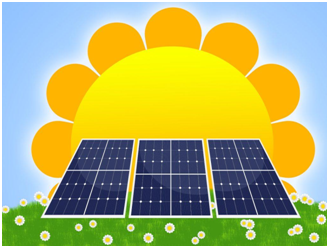
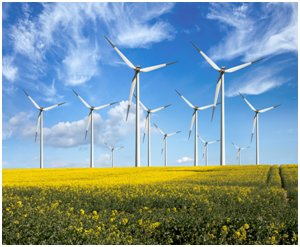
Q 2. How can resources be classified on the basis of origin?
On the basis of origin, resources can be classified into biotic and abiotic resources.
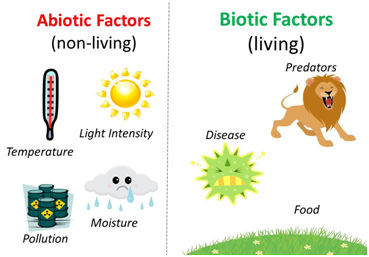
Q 3. What are the factors which help in the formation of soil?
Relief, parent rock or bedrock, climate, vegetation and other forms of life and time are important factors in the formation of soil.
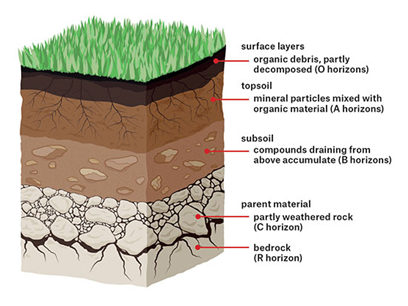
Q 4. Which soil is also known as cotton soil?
Black soil is known as cotton soil.
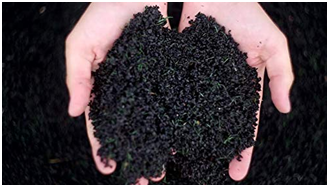
Q 5. What do you mean by ‘international resources’?
The oceanic resources beyond 200 nautical miles of the Exclusive Economic Zone are international resources.
Q 6. What is resource planning?
Resource planning is proper and judicious planning of resources.
Q 7. What is Agenda 21?
Agenda 21 is the declaration signed by world leaders in 1992 to combat environmental damage, poverty, disease through global cooperation on common interests, mutual needs and shared responsibilities.
Q 8. What do you understand by Resource ?
Everything available in our environment which can be used to satisfy our needs, provided, it is technologically accessible, economically feasible and culturally acceptable can be termed as ‘Resource’.
Q 9. Classify resources on the basis of exhaustibility.
Renewable and non-renewable resources.
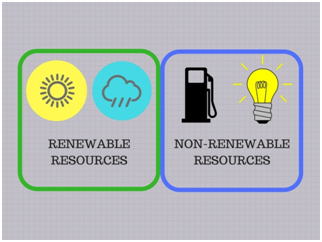
Q 10. Classify resources on the basis of development.
Potential, Developed, Stock and Reserves.
Q 11. Give an example of Biotic resources.
Human beings, flora and fauna are examples of biotic resources.
Q 12. Describe the features of red and yellow soils. Mention the places where they are found in India.
Red and yellow soils :
(a) Features :
1. These soils develop reddish colour due to diffusion of iron in crystalline and metamorphic rocks,
2. It looks yellow in a hydrated form.
3. They are highly porous and fertile when they are fine-grained and deep.
(b) Places : Red soil develops on crystalline igneous rocks in areas of low rainfall in the eastern and southern parts of the Deccan plateau. They are also found in parts of Orissa, Chhattisgarh, southern parts of the middle Ganga plain and along the piedmont zone of the Western Ghats.
Q 13. What are developed resources ?
Resources which are surveyed and their quality and quantity have been determined for utilization. The development of resources depends on technology and level of their feasibility.
Q 14. What is sustainable development ?
Sustainable economic development means ‘development should take place without damaging the environment and development in the present should not compromise with the needs of the future generations’.
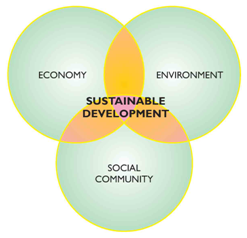
Q 15. What was the objective of Rio de Janeiro Earth Summit, 1992 ?
The Summit was convened for addressing urgent problems of environmental protection and socio-economic development at the global level. The assembled leaders signed the Declaration on Global Climatic Change and Biological Diversity .
Q 16. Which states in India are rich in minerals and coal deposits ?
Jharkhand, Chhattisgarh and Madhya Pradesh and Odisha .
Q 17. How did Gandhiji voice his concern about resource conservation ?
Gandhiji said, “There is enough for everybody’s need and not for any body’s greed.”
Q 18. What was the main reason for the colonial countries to exploit resources of countries under their control ?
High level of technological development.
Q 19. Which report in 1987 introduced the concept of ‘Sustainable Development’ ?
Brundtland Commission Report.
Q 20. How much area of land in India is plain and what is its importance ?
About 43 per cent of the land area is plain. It provides facilities for agriculture and industry.
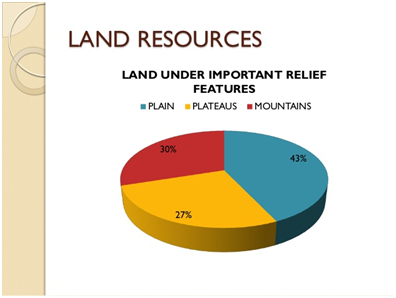
Q 21. What is the use of mountains ?
Mountains ensure perennial flow of some rivers, provide facilities for tourism and ecological aspects.
Q 22. What is total geographical area of India ?
3.28 million sq. km
Q 23. When the National Forest Policy was formed in India ?
1952
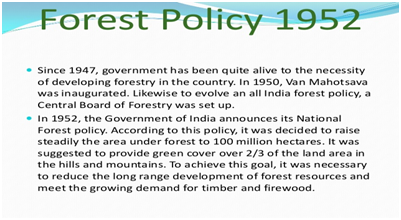
As of now India’s forests are governed by the National Forest Policy, 1988 . It has environmental balance and livelihood at its centre.
Salient Features and Goals:
- Maintenance of environmental stability through preservation and restoration of ecological balance.
- Conservation of Natural Heritage (existing) .
- Checking Soil Erosion and Denudation in catchment areas of rivers, lakes, and reservoirs.
- Checking extension of sand dunes in desert areas of Rajasthan and along coastal tracts.
- Substantially increasing Forest/Tree Cover through Afforestation and Social Forestry.
- Taking steps to meet requirements of fuel, wood, fodder, minor forest produces, soil and timber of Rural and Tribal Population.
- Increasing the productivity of Forests to meet National Needs.
- Encouraging efficient utilization of Forest Produce and Optimum Use of Wood (Timber).
- Generation of Work Opportunities, the involvement of Women.
Q 24. How much degraded land is in India ?
At present there are about 130 million hectares of degraded land in India.
Q 25. Which are the factors that determine the use of land ?
The factors are topography, climate, soil types, population, density, technological capability and culture and traditions.
Q 26. State factors responsible for land degradation.
Overgrazing, mining, quarrying and deforestation.
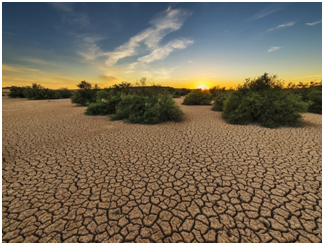
Q 27. Which are the ways to solve the problems of land degradation ?
1. Overgrazing – Gujarat, Rajasthan Madhya Pradesh and Maharashtra.
2. Over-irrigation – Punjab, Haryana, western Uttar Pradesh.
Q 29. Which part of India is made of alluvial soil ?
The entire Northern Plains are made of alluvial soil.
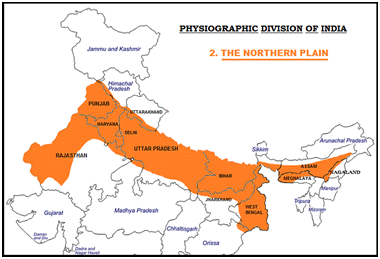
Q 30. How are alluvial soils classified on the basis of their age ?
According to their age alluvial soils can be classified as old alluvial soil — Bangar and new alluvial – Khadar.
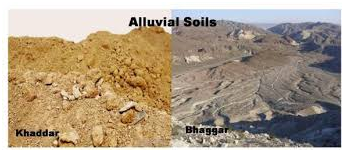
Q 31. What is the other name of black soils ?
Regur soils.
Q 32. Write a note on the Rio de Janeiro Earth Summit 1992.
(1) Place : In June 1992, more than 100 heads of states met in Rio de Janeiro in Brazil for the first International Earth Summit.
(2) Objective : The Summit was convened for addressing urgent problems of environmental protection and socio-economic development at the global level.
(3) Achievements :
a. The assembled leaders signed the Declaration on Global Climatic Change and Biological Diversity,
b. The Rio convention endorsed the Global Forest Principles and adopted Agenda 21 for achieving Sustainable Development in the 21st century.
Q 33. State one feature of laterite soils.
The laterite soils are suitable for cultivation with adequate doses of manures and fertilisers.
Q 34. Which soil is suitable for production of Cashew Nut and where ?
Red laterite soil in Tamil Nadu, Andhra Pradesh and Kerala is suitable for the crop of cashew nuts.
Q 35. Which are two causes for soil erosion ?
Deforestation, overgrazing and mining activities.
Q 36. What are ravines ?
The land that becomes unfit for cultivation is known as bad land. In the Chambal basin such badlands are called ravines.
Q 37. What is the significance of the shelter belts in the desert in western India ?
The shelter belts have contributed significantly to the stabilization of sand dunes and in stabilizing the desert in western India.
Q 38. Where are red and yellow soils found ?
Red and yellow soils are found in the eastern and southern parts of the Deccan plateau, in parts of Orissa, Chattisgarh, southern parts of the middle Ganga plain and along the piedmont zone of the Western Ghats.
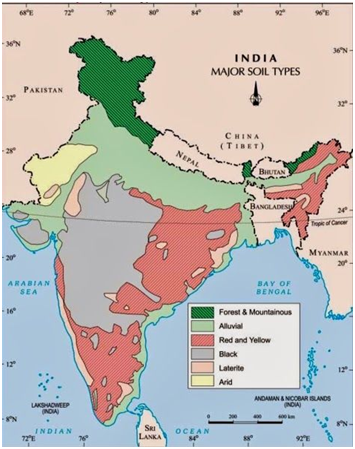
Q 39. What is the use of contour ploughing ?
Ploughing along the contour lines can decelerate the flow of water down the slopes.
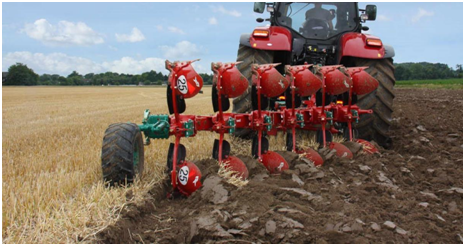
Q 40. What is Bad land?
When an area undergoes gully erosion, it becomes unfit from cultivation. This piece of land is known as badland. For exp: The badland in the Chambal basin is called ravine.
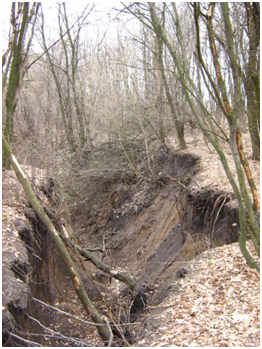
Q 41. What is resource planning? Give three phases of resource planning.
Resource planning is proper and judicious planning of resources.
The phases of resource planning are:
• Identification and inventory of resources across various regions of the country. It involves surveying, mapping, qualitative and quantitative estimation and measurement of the resources.
• Evolving a planning structure, endowed with appropriate technological skill and institutional set up for implementing resource development plans.
• Matching the resource development with overall national development plans.
Q 42. Define resources. How are resources classified?
Anything which can be used to satisfy our needs is technologically accessible, economically feasible and culturally acceptable can be termed as ‘Resource’.
The resources can be classified into various categories:
• On the basis of origin – biotic and abiotic
• On the basis of exhaustibility – renewable and non-renewable
• On the basis of ownership – individual, community, national and international
On the basis of status of development – potential developed stock and reserves.
Q 43. Describe any three steps that can be taken to solve the problem of land degradation?
Three steps that can be taken to solve the problem of land degradation:
• Afforestation and proper management of grazing.
• Planting of shelter belts of plants and control on over grazing.
• Proper management of waste lands and control of mining activities.
Q 44. Describe the features of Arid soils and Forest soils. Mention the places where they are found in India.
(a) Arid soils :
1. Features
- They range from red to brown in colour.
- They are generally sandy in texture and saline in nature,
- In some areas the salt content is very high and common salt is obtained by evaporating the water. Due to the dry climate, high temperature, evaporation is faster and the soil lacks humus and moisture,
- The lower horizons of the soil are occupied by kankar because of increasing calcium content downward.
- These soils can become cultivable if irrigation facilities are made available as has been in the case of western Rajasthan.
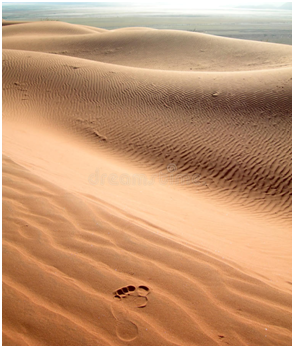
2. Places :
- These soils are found in arid areas of Rajasthan, Punjab and Haryana.
(b) Forest soils :
1. Features :
- They are found in mountainous area,
- They are loamy and silty in valley slides and coarse grained in the upper slopes,
- In the snow covered areas of the Himalayas they are acidic with low humus content.
Q 45. Describe the type of resources classified on the basis of exhaustibility.
The resources on the basis of exhaustibility are classified into two categories:
• Renewable Resources: The resources which can be renewed or reproduced by physical, chemical or mechanical processes are known as renewable or replenishable resources. For example, solar and wind energy, water, forests and wildlife, etc.
• Non-Renewable Resources: These resources take millions of years in their formation. Minerals and fossil fuels are examples of such resources. Some of the resources like metals are recyclable and some like fossil fuels cannot be recycled and get exhausted with their use.
Q 46. Describe the steps to control soil erosion in hilly areas?
The soil erosion in hilly areas can be controlled by:
• Contour ploughing: Ploughing along the contour lines can decelerate the flow of water down the slopes.
• Terrace cultivation: Steps can be cut out on the slopes making terraces which restricts erosion.
• Strip cropping: Large fields are divided into strips and strips of grass are left to grow between the crops.
Q 47. Why is resource planning essential?
It is essential to have resource planning because:
• Resources are limited in supply.
• Resources are unevenly distributed over the surface of the earth.
• Exploitation and over utilization of resources must be checked.
Q 48. What are biotic and abiotic resources ? Give two examples for each.
On the basis of origin resources are divided as given below :
1. Biotic resources : These are obtained from biosphere and have life such as human beings, flora and fauna, fisheries and livestock.
2. Abiotic resources : All those things which are composed of non-living things are called abiotic resources e.g., rocks and metals.
Q 49. Provide a suitable classification for resources on the basis of ownership. Mention main features of any three types of such resources.
These are divided as individual, community owned, national and international resources.
(a) Individual resources :
1. These are owned privately by individuals,
2. Many farmers own land in the villages which is allotted to them by government against payment of Revenue.
3. Urban people own plots, houses and other property.
4. Plantation, pasture lands, ponds are also owned by individuals.
(b) Community owned resources :
1. These are owned by community.
2. These are accessible to all the members of the community.
3. Village commons (grazing grounds, burial grounds), public parks, picnic spots in urban areas are accessible to all the people living there.
(c) National resources :
1. These are owned and belong to the nation or state,
2. All the minerals, water resources, forests, wildlife land within the political boundaries and oceanic area up to 12 nautical miles (19.2 km) from the coast termed as territorial water and resources there in belong to the nation.
(d) International resources :
These do not belong to any country. Some of these resources are regulated by international institutions. Oceanic resources beyond 200 km of the Exclusive. Economic Zone belongs to open ocean and no individual country can utilize these without the concurrence of international institutions.
Q 50. Differentiate between stock resources and reserves.
These can be divided into four types :
(a) Potential resources: These are found in a region but have not been utilized, e.g., enormous potential for the development of wind and solar energy in Rajasthan and Gujarat. But so far these have not been developed properly.
(b) Developed resources :
1. Resources whose quality and quantity have been determined for utilisation.
2. Their development depends on technology and their level of feasibility.
(c) Stock :
Materials in the environment which can satisfy human needs but human beings do not have the appropriate technology to access these e.g., two components of water — hydrogen and oxygen can be used as a rich source of energy but we, human beings, do not have the technology to use them. Hence it is considered as stock.
(d) Reserves :
1. These are the subset of the stock which can be used by present technology but their use has not been started fully. (Here subset of the stock means that just like stock resources , reserve resources are also not used at present ). 0
2. River water can be used for generating hydroelectric power but presently it is being used only to a limited extent.
3. Such resources can be used for meeting future requirements.
4. Water in the dams, forests etc. is a reserve which can be used in the future.
Q 51. What do you mean by resources? What are the types or kinds of resources?
Everything available in our environment which can be used to satisfy our needs, provided, it is technologically accessible, economically feasible and culturally acceptable can be termed as ‘Resource’
Q 52. What is the role of humans in resource development?
- Human beings facilitate transformation of things available in our environment with the help of technology and institutions
- Human beings interact with nature through technology and create institutions to accelerate their economic development
- They transform material available in our environment into resources and use them.
Q 53. Humans often think that resources are free gifts of nature? Is this thought justified? Why?
This thought is absolutely wrong and it has led to the following major problems –
- Depletion of resources for satisfying the greed of a few individuals
- Accumulation of resources in few hands, which, in turn, divided the society into two segments i.e. haves and have nots or rich and poor.
- Indiscriminate exploitation of resources has led to global ecological crises such as, global
warming, ozone layer depletion, environmental pollution and land degradation.
Q 54. How shall resources be distributed and why?
The distribution of resources shall be equitable for a sustained quality of life and global peace.
If the present trend of resource depletion by a few individuals and countries continues, the
future of our planet is in danger.
Q 55. What was Rio de Janeiro Earth Summit, 1992?
In June 1992, more than 100 heads of states met in Rio de Janeiro in Brazil, for the first
International Earth Summit. The Summit was convened for addressing urgent problems of
environmental protection and socio-economic development at the global level. The assembled
leaders signed the Declaration on Global Climatic Change and Biological Diversity. The Rio
Convention endorsed the global Forest Principles and adopted Agenda 21 for achieving
Sustainable Development in the 21st century.
Q 56. What is resource planning? How is it done?
Resource planning is a complex process which involves :
1. Identification and inventory of resources across the regions of the country. This involves
surveying, mapping and qualitative and quantitative estimation and measurement of the
resources.
2. Evolving a planning structure endowed with appropriate technology, skill and institutional set up for implementing resource development plans.
3. Matching the resource development plans with overall national development plans. Mere availability of resources does not solve the purpose, it is essential that they shall be utilised well. There are some regions in the country where the resources are available but still are not developed and vise versa. Therefore planning is a vital concern.
Q 57. Which is the most important and widely spread soil in India. What are its characteristics?
The alluvial soil is the most widely spread and important soil in India. The entire northern
plains are made of alluvial soil and they extend in Rajasthan and Gujarat through a narrow
corridor.
Formation – These have been deposited by three important Himalayan river systems– the
Indus, the Ganga and the Brahmaputra.
Presence except northern plains – Alluvial soil is also found in the eastern coastal plains
particularly in the deltas of the Mahanadi, the Godavari, the Krishna and the Kaveri rivers.
Composition – The alluvial soil consists of various proportions of sand, silt and clay. As we move inlands towards the river valleys, soil particles appear some what bigger in size. In the upper reaches of the river valley i.e. near the place of the break of slope, the soils are coarse. Such soils are more common in piedmont plains such as Duars, Chos and Terai.
Types – According to their age alluvial soils can be classified as old alluvial (Bangar) and new alluvial (Khadar). The bangar soil has higher concentration of kanker nodules than the Khadar.
It has more fine particles and is more fertile than the bangar.
Fertility – Alluvial soils as a whole are very fertile as mostly these soils contain adequate
proportion of potash, phosphoric acid and lime.
Crops grown – Due to adequate proportion of potash, phosphoric acid and lime which are ideal for the growth of sugarcane, paddy, wheat and other cereal and pulse crops.
Q 58. How is Red soil formed? What are its characterstics?
Red soil develops on crystalline igneous rocks due to weathering in areas of low rainfall in the eastern and southern parts of the Deccan plateau.
- These soils develop a reddish colour due to diffusion of iron in crystalline and metamorphic rocks.
- Yellow and red soils are also found in parts of Odisha, Chhattisgarh, southern parts of the middle Ganga plain and along the piedmont zone of the Western Ghats.
- It is sometimes known as yellow soil and it looks yellow when it occurs in a hydrated form.
Q 59. Explain the formation and basic features of Laterite soil.
Formation – The laterite soil develops under tropical and subtropical climate with alternate wet and dry season. This soil is the result of intense leaching due to heavy rain.
Areas in which it is found – It is mostly found region of Maharashtra, Odisha, some parts of
West Bengal and North-east regions.
Crops grown – After adopting appropriate soil conservation techniques particularly in the hilly areas of Karnataka, Kerala and Tamil Nadu, this soil is very useful for growing tea and coffee.
Red laterite soils in Tamil Nadu, Andhra Pradesh and Kerala are more suitable for crops like
cashew nut.
Laterite has been derived from the Latin word ‘later’ which means brick.
Q 60. Explain farming techniques which can be used for soil conservation.
Contour ploughing – Ploughing along the contour lines can decelerate the flow of water down
the slopes. This is called contour ploughing.
Terrace Farming – Steps can be cut out on the slopes making terraces.
Terrace cultivation restricts erosion.
Western and central Himalayas have well developed terrace farming
Strip cropping – Large fields can be divided into strips. Strips of grass are left to grow between
the crops. This breaks up the force of the wind. This method is known as strip cropping.
Shelter Belts – Planting lines of trees to create shelter also works in a similar way as that of strip farming.
Rows of such trees are called shelter belts.
These shelter belts have contributed significantly to the stabilisation of sand dunes and in stabilising the desert in western India.
Q 61. What is soil erosion ?
Soil erosion is the removal of the top fertile layer of soil by natural agents such as wind, water, and human activities. This process degrades the quality of soil and reduces its fertility, making land unsuitable for agriculture and vegetation.
Q 62. What are the natural causes of soil erosion?
The natural causes of soil erosion include:
- Water (running water): Heavy rainfall leads to surface runoff, which removes the topsoil.
- Wind: In arid and semi-arid a0reas, strong winds blow away loose soil.
- Glaciers: Glaciers scrape soil from mountain slopes.
- Floods: They carry away large amounts of soil.
- Droughts: They loosen the soil, making it easier to be carried by wind.
Q 63. How do human activities cause soil erosion?
Human-induced causes of soil erosion include:
- Deforestation: Removal of trees exposes the soil.
- Overgrazing: Livestock overgrazing removes vegetation cover.
- Mining: Mining activities loosen the soil.
- Construction: Urban expansion disturbs land surfaces.
- Poor farming practices: Like ploughing along slopes and intensive cropping.
Q 64. What are the types of soil erosion prevalent in India?
The major types of soil erosion in India are:
Type of Erosion | Description | ||
Sheet Erosion |
| ||
Rill Erosion | Small finger-like channels are formed on the surface. | ||
Gully Erosion | Deep cuts form gullies, making land unfit for cultivation (common in Chambal Valley). | ||
Wind Erosion |
|
Q 65. What are the effects of soil erosion?
The effects of soil erosion include:
- Loss of fertile topsoil.
- Reduced agricultural productivity.
- Desertification of land.
- Siltation of rivers and dams.
- Ecological imbalance and loss of biodiversity.
Q 66. What is the difference between soil erosion and soil conservation?
Soil Erosion | Soil Conservation |
The removal of topsoil by wind, water, or human activity. | Protecting and managing soil to prevent erosion. |
Leads to land degradation and infertility. | Aims to maintain soil health and fertility. |
Q 67. What steps can be taken to conserve soil and prevent erosion?
Soil conservation methods include:
- Afforestation: Planting more trees to hold soil.
- Contour Ploughing: Ploughing along the contour lines of hills.
- Terrace Farming: Making terraces on slopes to reduce runoff.
- Strip Cropping: Growing crops in alternating strips to reduce wind effect.
- Shelter Belts: Planting rows of trees to break wind force.
- Checking overgrazing and mining.
Proper irrigation techniques to avoid waterlogging and erosion.
Q 68. Explain the role of the government and society in preventing soil erosion.
The government and society play vital roles:
- Launching awareness campaigns about afforestation and sustainable farming.
- Implementing soil conservation projects in erosion-prone areas.
- Enforcing laws against deforestation and overgrazing.
- Supporting research and education for better soil management.
- Promoting community involvement in conservation programs.
Q 69. In which parts of India is soil erosion most severe? Why?
Severe soil erosion is found in:
- Chambal Valley (MP, Rajasthan, UP): Gully erosion due to loose soil and deforestation.
- Rajasthan and Gujarat: Wind erosion due to dry climate and loose sand.
Hilly areas of the Himalayas and the Western Ghats: Water erosion from heavy rainfall and deforestation.
The main reasons are improper land use, deforestation, steep slopes, and lack of soil conservation.
Q 70. What is badland topography and how is it related to soil erosion?
Badland topography refers to a rugged and uneven land surface formed due to excessive gully erosion. It is characterized by deep gullies, canyons, and barren land. This occurs when unchecked water erosion continues for a long time, especially in regions like the Chambal basin in India.
Q 71. Why is topsoil considered the most fertile part of the soil?
Topsoil is the uppermost layer of the soil which contains humus, minerals, microorganisms, and nutrients necessary for plant growth. It supports most biological activity and is crucial for agriculture. Hence, its erosion directly affects productivity.
Q 72. How does deforestation contribute to soil erosion?
Deforestation leads to the removal of vegetation that binds the soil together. Without roots to hold it, soil becomes loose and easily washed or blown away by water or wind. This accelerates soil erosion, especially on slopes.
Q 73. Explain how contour ploughing helps in preventing soil erosion.
Contour ploughing involves ploughing across the slope (along contour lines) rather than up and down. This technique reduces runoff by forming ridges that slow water flow, thereby preventing the washing away of topsoil.
Q 74. What are the main features of gully erosion?
- It creates deep, narrow cuts or channels in the soil.
- Common in rain-fed plateau regions.
- Converts fertile land into wasteland or badlands.
- Often seen in Chambal Valley in Madhya Pradesh.